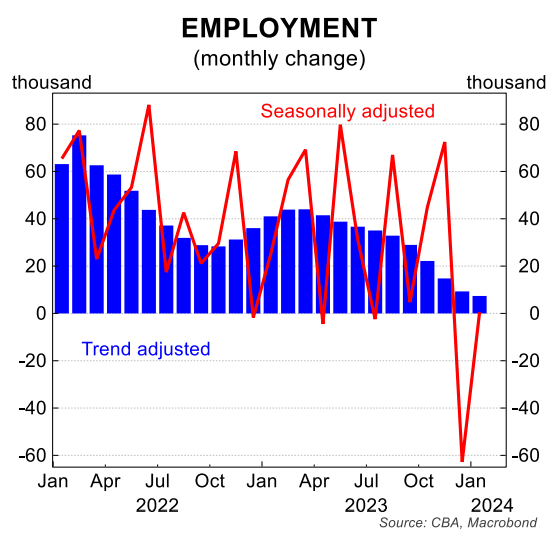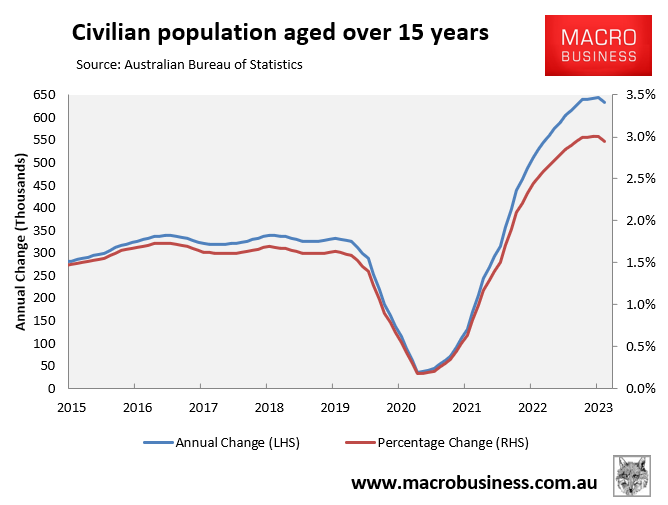Over the weekend, I was interviewed by Luke Grant on Radio 2GB, where we discussed the sharp deterioration of Australia’s labour market and housing affordability, both of which are being negatively impacted by the federal government’s mass immigration policy.
Below are highlights from the interview, along with key charts.
ABS Labour Force data:
The January labour force data from the ABS was a complete shocker.
The headline unemployment rate rose again to 4.1%. That was worse than what economists had expected, which was 4.0%. It was also worse than the RBA’s forecast.

The underemployment rate, which is people who want more work, also rose.
But the bigger concern here is not so much the headline unemployment number. It was the fact that employment growth completely stalled.
So, the number of jobs created over the past 3 months to January was only 10,200. And that’s the softest pace of job growth since the Delta outbreak during the pandemic in 2021.

There’s also been a big pivot from full-time jobs to part-time jobs. Over the January quarter, we lost 41,000 full-time jobs and we gained 51,000 part-time jobs.
And because of this, the number of hours worked across the economy has basically been falling for six straight months and it’s only 0.7% over the year to January.

The reason that’s bad is because the working age population grew by 2.9% over the year to January. So, the hours worked has gone up 0.7% but we’ve had a 2.9% rise in the working age population, primarily because of this high immigration.

What it basically means is Australia is not creating enough jobs and hours to soak up population growth. And according to Commonwealth Bank research, Australia needs to create 35,000 jobs per month just to keep the unemployment rate stable…

The reason why we need 35,000 jobs is twofold. Number one and most importantly, we’re running a high immigration program. So, effectively the labour supply is growing very quickly because so many people are coming into the country.
Secondly, and this is less important, all those extra babies we had during the baby bonus time of Peter Costello in the early 2000s are now hitting adult working age. So they’re also entering the labour market.
So effectively, we’ve got this really strong record growth in labour supply, which basically needs jobs to ensure that we can soak them up. And if we don’t create enough jobs, unemployment is going to rise.
And that’s effectively the sort of situation we find ourselves in…
With all these people competing for jobs, and with the jobs becoming more scarce, we’re going to get slower wage growth as well. So that also means lower household income growth…
We’re in a per capita recession. We’ve got high interest rates. Australia has no chance of creating 35,000 jobs on average per month, which means the unemployment rate is going to keep rising.
The only silver lining is that the Reserve Bank’s latest Statement of Monetary Policy predicted that the unemployment rate would end the year at 4.3%, which is only 0.2% higher than it was in January.
In my view, it’s likely to be closer to 5%, which means that the Reserve Bank’s going to be forced to cut interest rates a lot quicker than anyone expects because the economy is weakening quicker.
So that’s the only silver lining if you’re a mortgage holder…
Housing shortage:
There was no plan for this immigration influx. The Jobs and Skills Summit in September 2022 was completely rigged. It was rigged to drive a Big Australia.
The Albanese Government stacked the summit full of pro-immigration lobby groups and then Clare O’Neal, Andrew Giles, and Anthony Albanese all came out and said: “hey look, we’ve got this really strong consensus for immigration. It’s amazing how much consensus there. Everybody wants high immigration”.
Of course they did because they stacked the Summit with lobbyists and Big Australia rent Seekers.
18 months down the track we’re living with the consequences. There’s never been any thought to how we are gong to provide the infrastructure, how we are going to provide the houses, and all the usual negative external impacts you get from this sort of stuff.
They never think about that. They always just open up the fire hose and then worry about the consequences later…
They always paint the housing crisis as a supply issue. We’re supposedly not building up. We’re not building enough homes.
They never look at demand side. They never look at the fact that the federal government is fire hosing in more people into Sydney, Melbourne, and Brisbane than we can build houses and infrastructure for.

That’s creating a lot of problems, and it’s driving people out because they can’t afford to live there anymore.
It’s all very basic common sense. But they never bother to mention it.

